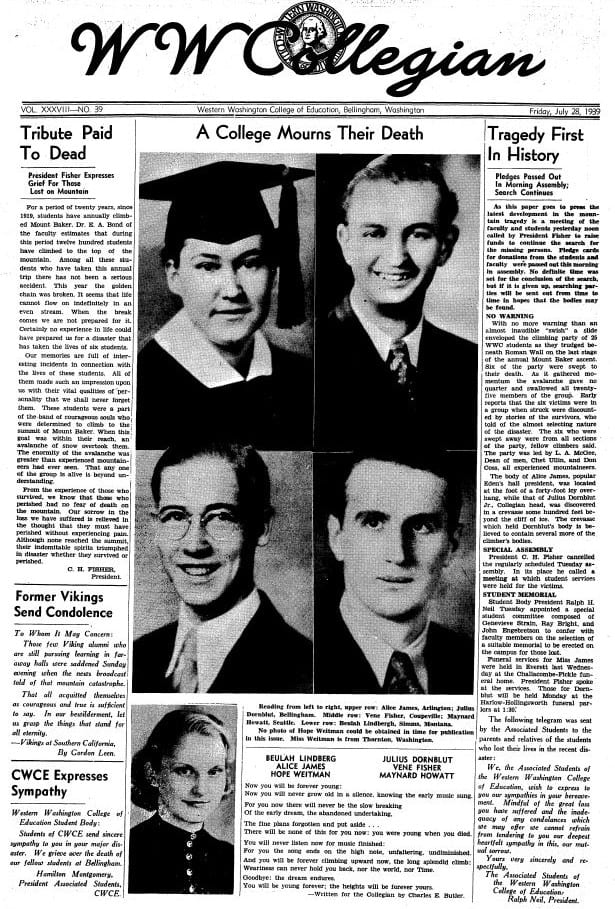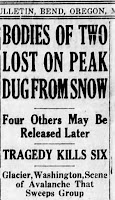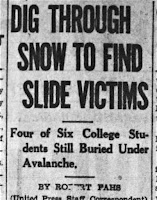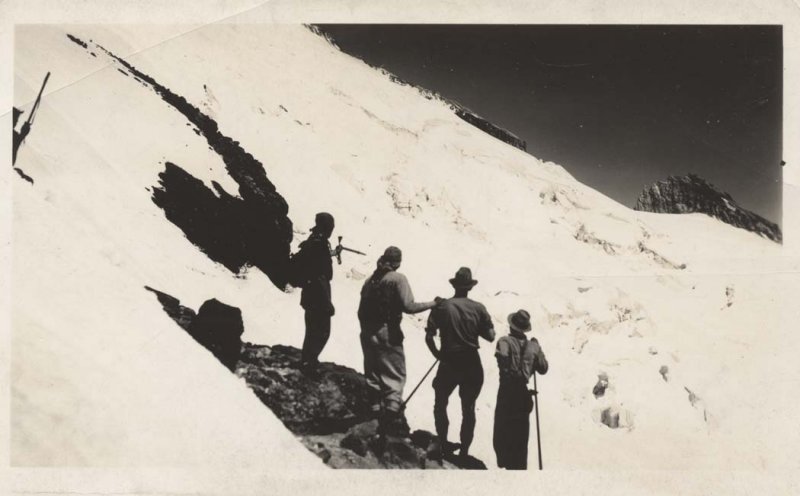Front page of the July 28, 1939 Western Washington College of Education student newspaper the WWC Collegian, now titled the Western Front. Digitized by Special Collections, Western Libraries Heritage Resources, Western Washington University.
A local tragedy that took the lives of six young affiliates of Western Washington College of Education (now Western Washington University) inspired one of Ella Higginson’s most touching memorial poems “A Sepulchre
of Snow.”
Headlines from various newspapers: July 24, 1939 The Bend Bulletin of Bend, OR; July 24, 1939 The Eugene Guard of Eugene, OR; July 24, 1939 The Vidette Messenger of Valparaiso, IN.
On July 22, 1939 a group of twenty-five experienced
mountain climbers were fifteen minutes from the summit of Mount Baker during the 20th annual climb hosted by Western Washington College of Education when an avalanche the width of a football field swept
the entire party a mile down the mountain. The tumbling snow spilled over into
a crevasse in the mountain seventy feet deep. When the slide had ceased, seven
members were missing.
The two guides of this expedition frantically searched
the vast snowscape and managed to find Elizabeth Beers clinging to the mouth of
the crevasse by her fingertips. Two other members of the party raced down the
mountain and reached William N. Parke, the current district forest ranger at
Mt. Baker, and alerted him of the disaster. Parke immediately gathered both a
rescue team and supplies and initiated a search that would last six days,
hoping to find six bodies. They found two. The body of Alice James and Julius
Dornblut were recovered from the top few feet of snow that filled the crevasse.
It is believed that the remaining victims’ bodies were piled under dozens of
feet of hardening snow in the crevasse near the bottom of the slide.
An unidentified hat and handkerchief were found later,
as well as the glasses of Vene Fisher.
Members of the search party surveying the path of the avalanche. Photograph by John Scurlock, July 1939.
At the time, the Mt. Baker avalanche of 1939 became
the worst mountain tragedy in Washington State history. In light of the
disaster, Higginson wrote three poignant and haunting sentences titled
“A Sepulchre of Snow.”
Of
all beautiful burial places on this lovely earth, if I might choose my own, my
choice would surely be to lie in the depths of a crevasse, covered with
perpetual snow; and with my name visibly etched by God upon a majestic mountain
for an enduring monument.
Think
of the sunrises and the sunsets; think of the moonlight on those silvery
slopes; think of how large and brilliant are the stars that keep ceaseless
watch over those silent places.
Through
the ages to be identified with one of the most beautiful mountains known; to
lie there forever, on the silver crest of the world, close to God—my brothers,
do you know anything lovelier after death than this would be?
On Western Washington University’s campus, at the
north end of Old Main, is a memorial erected in honor of the victims: Julius
Dornblut, Vene Fisher, Maynard Howat, Alice James, Beulah Lindberg, and Hope
Weitman.
The line “You will be forever climbing upward now” is
taken from a memorial poem written by Charles E. Butler, who was the current reference
librarian for the college.
Julius Dornblut was born in Radersburg, Montana on
January 23, 1909. He received his BA from Western Washington College of
Education in 1935. For the past four years he had taught at Alderwood Manor in
the Edmond’s school district. At the time of his death, he was fulfilling the
roles of adviser and editor of the WWC
Collegian and was vice-president of the Alumni Association. He was survived
by two sisters.
Vene Fisher was born in Brady, Montana on June 21,
1914. The avalanche occurred the day after his twenty-fifth birthday. He
received his BA from Western Washington College of Education in 1936. He taught
for a year in Grays Harbor County, then had been an assistant in the county
engineer’s office of Island County for the past two years. He was survived by
his wife Hazel Lindquist Fisher, his parents, two brothers, and one sister.
Maynard Howat was born in Seattle, Washington on May
3, 1915. He was scheduled to complete his three year degree at Western
Washington College of Education less than a month later on August 18, 1939. A
veteran trackman, Howatt captured a conference title for the two-mile run twice
while attending college. He was survived by his parents, one brother, and one
sister.
Alice James was born in Valley City, North Dakota on
June 3, 1917. While attending Western Washington College of Education, she was
a member of the orchestra and the library student staff. She left the college
halfway through the 1938-39 academic year to teach in Standwood and planned to
return there in the fall. She was survived by her parents, three sisters, and a
brother.
Beulah Lindberg was born in Simms, Montana on October
9, 1916. She attended the State Teachers’ College at Dillon, Montana then
taught in both Belt and Fairfield, Montana. She was visiting friends also of
Montana origin who lived here in Bellingham when she was killed by the
avalanche. She was survived by her parents in her hometown.
Hope Weitman was born in Prairie City, Oregon on
September 28, 1915. She graduated from Eastern Washington College of Education
in Cheney and had taught in Chewelah. She was attending summer classes at
Western Washington College of Education and was residing at the Bellingham
YWCA. She was survived by her parents.

“A Sepulchre of Snow” printed on a card ca. 1939. Courtesy of Special Collections, Western Libraries Heritage Resources, Western Washington University.









